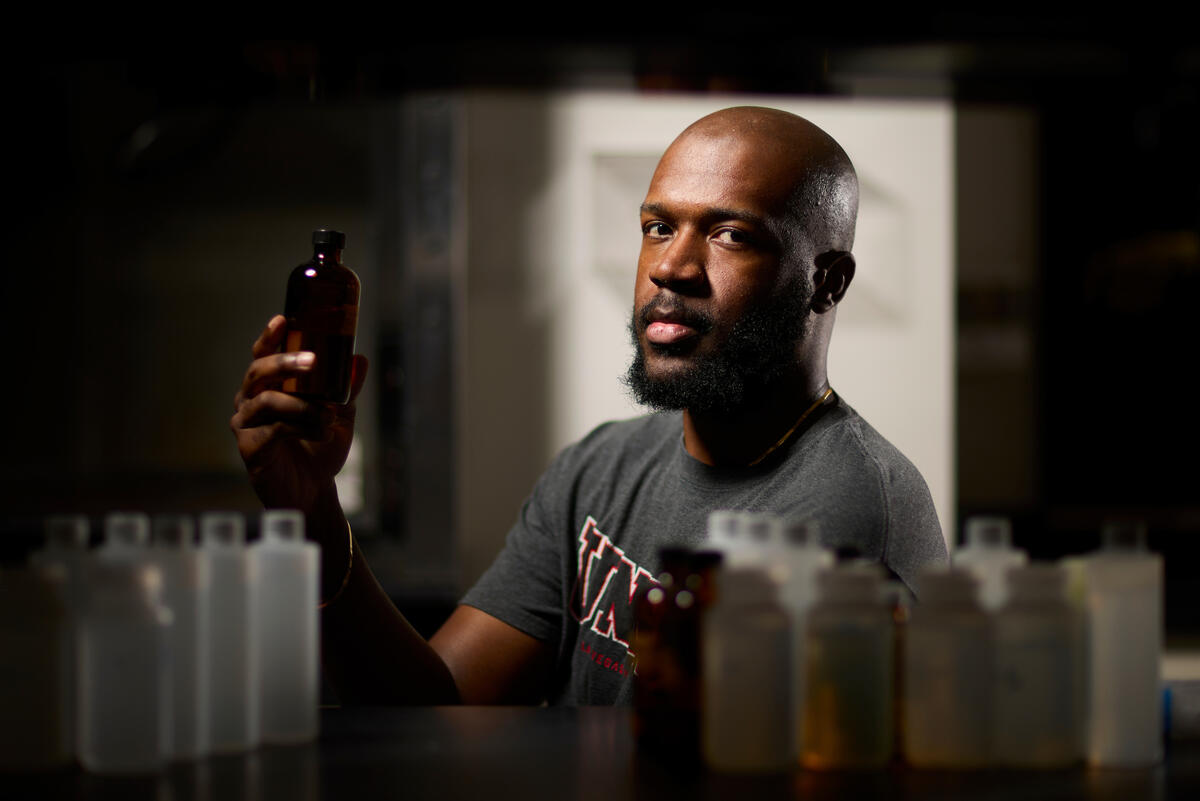Haven Searcy has always considered himself to be a "science nerd." Growing up on the outskirts of Atlanta, Georgia, Searcy comes from a family of science enthusiasts with both of his parents holding degrees in biology. He knew he would pursue his own career in the sciences, though he wasn’t sure exactly what path he would take.
Finding his way to UNLV started with a campus visit when he was in high school. He later met Ronald Brown, dean of UNLV’s School of Integrated Health Sciences, and Steen Madsen, professor and chair of Health Physics and Diagnostic Sciences, when the two visited Fort Valley State University where Searcy was an undergraduate student.
UNLV and Fort Valley State had an established partnership where select science students at the HBCU (historically Black colleges and universities) could attend UNLV on a full scholarship to pursue a second degree.
Now, Searcy is a two-time health physics graduate from UNLV and recently won a Junior Investigator Award for his study on nuclear radiation at the Nevada National Security Site during the Council on Ionizing Radiation Measurements and Standards’ (CIRMS) annual conference in Maryland.
This summer he's working at a national research lab and is confident he's on the right path with health physics.
What drew you to UNLV?
I first came to UNLV as a high schooler to learn more about the opportunities available here. Professor Madsen gave a presentation about health physics, and it really drew me in. I didn’t know anything about health physics until his presentation. He explained to us what UNLV had to offer, and of all the possible partnership programs offered through Fort Valley State, health physics was the most interesting to me.
I also really enjoyed the desert botany here. Growing up in Georgia, I always saw a lot of green. When I came to UNLV, I saw cacti with rocks, and it was all so new to me.
What were you studying before you came to UNLV?
I graduated with my bachelor’s degree in chemistry from Fort Valley State, and health physics seemed like the natural progression after studying chemistry. I had always remembered my campus visit to UNLV from high school and wanted to come here to study health physics.
Can you tell us about your study on nuclear fallout at the Nevada National Security Site?
Our project, “No Nuclear Fallout Radioactivity Was Found on Public Zones Around the Nevada National Security Site: A Recent Study,” was proposed by [health physics and diagnostic sciences associate professor] Zaijing Sun, one of my mentors. He had performed similar studies on radiation exposure in Spanish moss.
The Nevada National Security Site was a key location in the production and development of nuclear weapons during and after World War II. More than 900 atomic bomb tests were conducted from 1951 to 1992, culminating with the global nuclear weapons testing moratorium and subsequent test ban treaty. Out of those tests performed, 100 were performed above ground, resulting in significant amounts of contamination in the area.
We mostly analyzed desert flora, including desert bushes, creosote bushes, and Joshua trees to assess environmental exposure. Joshua trees can live up to 80 years, whereas desert bushes only live for about a year. This gave us an understanding of their different lifespans since some flora had been there during the nuclear weapons testing. Using neutron activation analysis, we ran tests, and with the help of the University of California, Irvine’s lab, concluded that there wasn’t any substantial radioactive fallout in the air or in the plants.
What was your reaction to winning the Junior Investigator Award during the CIRMS annual conference?
Honestly, I was quite shocked. There were about 15 other presentations by master’s and doctorate students from universities around the country, so this was a pleasant surprise. I hadn’t met many health physicists before that competition. It was nice to be honored by such a prestigious group.
Now that you’ve graduated with your master’s from UNLV, what comes next?
Right now, I’m working with the Lawrence Livermore National Laboratory in California. I’m involved with their personal radiation detectors system, and I also work with their international exchange program. We work on preparation for nuclear events, including where it might spread, different release patterns, things like that.
Once that wraps up in August, I’d love to stay in Nevada and work at the National Security Site, where we completed our study. They have a lot of health physics-related work available, and I’m confident that I’ll be able to fit right in.
How did your UNLV experience help you plan for your future?
UNLV has helped me ever since I took that first tour in high school. Once I graduated from Fort Valley State, I came to UNLV and got another bachelor’s in health physics. I hadn’t considered getting my graduate degree until associate professor Sun approached me about it.
I started at UNLV during the pandemic in 2020, so it was a different experience than I had planned for. But the faculty have always been supportive and have taught me so much throughout my time here.



